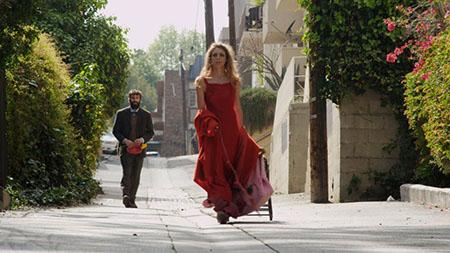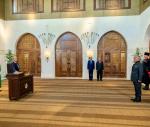You are here
Jordanian filmmaker takes on Dostoyevsky in ‘Strangely in Love’
By Hind Joucka - Apr 08,2015 - Last updated at Apr 08,2015

AMMAN — In his latest feature “Strangely in Love”, acclaimed Jordanian director Amin Matalqa adapts Fyodor Dostoyevsky’s short story “White Nights” into film, with a few tweaks.
The 2014 film is a light-hearted romantic comedy set in modern-day Los Angeles, following Fyo and Nastenka, two eccentric characters who meet by chance and fall into an unusual love story.
Matalqa, the filmmaker behind the celebrated Jordanian feature “Captain Abu Raed”, said he wanted to keep the core elements of Dostoyevsky’s story while playfully changing some details.
Nastenka, for example, is blind in the film contrary to the original work, because he “wanted to make a movie about love being blind, literally”.
Fyo, whose name is repeatedly mistaken for Fyodor in homage to Dostoyevsky, is a simple and gullible hero who falls helplessly in love with the peculiar Nastenka, who is in love with another man.
The Jordanian director said at the film’s Jordan premiere on Tuesday that he wanted to include fairytale elements in the film, evident through the various sceneries and locations, including Nastenka’s almost-mythical house.
According to Matalqa, the house was one of the original houses from Disney that was built in the 1920’s. The Disney princess’ house in the animated movie “Snow White and the Seven Dwarfs” house was reportedly modelled on it.
Nastenka’s character in itself depicts a modern-day princess. The film opens with a damsel-in-distress scenario where Fyo, in this case the accidental hero, comes to the rescue. Nastenka’s tone, motions, language, naïveté and her costumes all make her an almost-fictional persona.
The film was shot in only 15 days, with a modest budget and a small crew of almost 20 people, featuring Hollywood actress Amanda Plummer, according to the director.
“There are only four main actors in the film,” Matalqa said. “I decided to add unconventional main characters such as the camera, the city of Los Angeles and the music.
“The camera occasionally has a mind of its own and doesn’t follow the actors at all times, but instead allows them to move freely around in the setting while still maintaining the audience’s attention.”
Moreover, Matalqa said he wanted to capture the beauty of Los Angeles as a character of its own, showcasing it as a romantic city throughout the film while maintaining an element of its bleakness depending on the characters’ moods.
The director also wanted to portray the film’s background music as another character. “The music’s character develops throughout the film; for example the film starts with music in Charlie Chaplin style and ends with modern music.”
Matalqa describes the film as “Chaplinesque” as it features chapters that introduce the audience to characters and various whimsical plot twists in a style that mirrors the 1920’s silent films.
The Royal Film Commission hosted the film’s screening at the Rainbow Theatre.
Related Articles
AMMAN — Jordan nominated the feature-narrative film “Amira”, by Mohamed Diab, as its official entry for the 94th Academy Awards (Oscars) to
TOKYO — Celebrated Japanese animator Hayao Miyazaki won his second Oscar on Sunday with “The Boy and the Heron” — the Studio Ghibli co-found
LONDON — It may be no coincidence that Agent 007’s latest love interest, played by French actress Lea Seydoux in the new James Bond movie “S


















